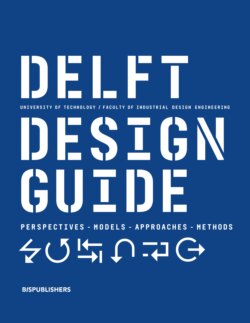Читать книгу Delft Design Guide -Revised edition - Annemiek van Boeijen - Страница 22
На сайте Литреса книга снята с продажи.
ОглавлениеDesign for Sustainability
What & Why? DfS means designing products and product-service systems that benefit the natural environment, enhance the well-being of communities around us (especially underprivileged and disadvantaged populations), and are conducive to economic prosperity.
Sustainability is essential to our well-being as well as to human survival in the long run. Designers have a responsibility to pay attention to the sustainability impacts that their work can have. This is not easy, and there is a tendency to treat sustainability as a desirable quality of the product-service system that should only be considered once other priorities have been established. We need to recognize that sustainability is not in competition with other requirements – it is a fundamental precondition for the continued existence of the product-service system, and it influences each design decision that is made.
Sustainability is not a problem that can be solved; it is more of a challenge that we should respond to intelligently and learn from while doing so. Sustainability is also systemic by na- ture. When you deal with one aspect of sustainability such as choosing a renewable material, you will automatically influence other aspects such as biodiversity loss. As a designer, you have to become a system thinker – any design intervention aiming to address a particular challenge will have co-benefits, spillover effects, and negative side effects, and these need to be understood in order for you to design an intervention with sustainable impact.
--------------------------------------------------------------------------------------------------------------------------
Mindset: The most important values a designer can bring to DfS are a sense of responsibility and a willingness to think in systems. Doing sustainable design means creating synergy between human well-being, planetary health, and economic prosperity. A design is not considered sustainable if it has many benefits for the well-being of people but results in ecological losses.
---------------------------------------------------------------------------------------------------------------------------
References & Further Reading: Shedroff, N., 2009. Design is the problem. The future of design must be sustainable. Rosenfeld, USA. / Crul, M., Diehl, J.C., Ryan, C. (Eds.). 2009. Design for Sustainability, a step-by-step approach. United Nations Environment Program. / Papanek, V.J., 1985. Design for the real world. Human Ecology and Social Change . Academy Chicago Publishers. / Bakker, C.A., 2019. Ten Golden Rules of Design for Sustainability . Proc. PLATE 2019, Product Lifetimes and the Environment, Berlin.
Tips & Concerns
Do not to let other priorities overtake the urgent need to address sustainability.
-------
Address sustainability right from the start of any product and service development project.
-------------------------------
Limitations
The success depends on many factors, not all of which can be controlled by designers.
-------
You need to be patient and even stubborn enough to keep bringing up the topic including its opportunities with clients and colleagues.
-------
You will have to deal with a lack of reliable data and other uncertainties in the projects you do.
-------
You need a long-term view and an open mind to keep monitoring societal and scientific developments, and you will need to adjust your design approach accordingly.
Any product or product-service system that you design will have an impact on society and the natural environment. Design for Sustainability (DfS) aims for net-positive impacts, namely beneficial outcomes for society and the natural environment. Understanding how to design for sustainability is a fundamental design skill.
perspectives
---------------------------------------------------------------------------------------------------------------------------------------------------------------
---------------------------------------------------------------------------------------------------------------------------------------------------------------
21
How? There are a number of approaches, each with advantages and drawbacks. If you are new to DfS, you could start with the Ecodesign Checklist and the Ecodesign Strategy Wheel, which together provide a good overview of the field. The drawback of Ecodesign is that it focuses on incremental improvements of existing products. If you want more fundamental approaches to DfS,
you can try Biomimicry, Cradle to Cradle, or Design for a Circular Economy. The Product Journey Map and the Sustainable Business Model Canvas are useful when designing for a circular economy.
Use the 10 Golden Rules of Design for Sustainability as a memory map. You should always take these 10 rules into account, no matter which DfS approach you choose!
1 Toxicity : Limit the use of toxic substances and, where such substances are essential, try to arrange closed material loops.
-------
2 Housekeeping: Review your routines to minimize energy and resource consumption in production and transport.
-------
3 Weight: Choose materials and designs that minimize the weight of the product.
-------
4 Energy: Think about how the end product
will be used and try to minimize the user’s energy and resource consumption.
-------
5 Upgrading: Design the product to allow upgrading and repair, especially for long lifespan and system-dependent products.
-------
6 Lifetime: Optimize the product for its intended working life.
-------
7 Protection: Invest in durable materials and surface treatments to protect the product.
8 Information: Prepare for upgrading, repair and recycling through accessibility, labeling, modular construction and manuals.
9 Mixing materials: This affects recyclability in a negative way. Try to use as few materials as possible in simple forms.
-------
10 Construction: Use as few joining elements as possible, avoid the unnecessary use of screws and bonding, and look for intelligent geometric solutions.
